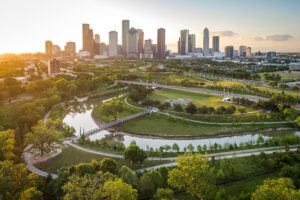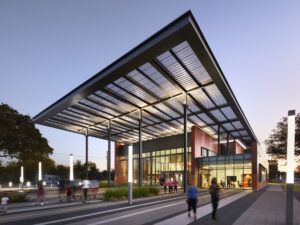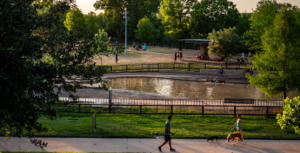 Sustainability is no longer a buzzword but a critical ethos shaping the future of urban development. As leaders in quality growth, we are at the forefront of this transformative movement. Sustainable parks are a tangible manifestation of our commitment to quality development and economic viability. Let’s delve into the essential elements that make a park sustainable by offering insights into design principles, ecological benefits, community impact, and technological innovations.
Sustainability is no longer a buzzword but a critical ethos shaping the future of urban development. As leaders in quality growth, we are at the forefront of this transformative movement. Sustainable parks are a tangible manifestation of our commitment to quality development and economic viability. Let’s delve into the essential elements that make a park sustainable by offering insights into design principles, ecological benefits, community impact, and technological innovations.
Ecological Design Principles
At the heart of sustainable parks is the integration of ecological design principles. These principles aim to create harmonious relationships between the natural environment and human activities. Ecological design seeks to enhance the ecosystem services provided in a project area. Ecological services are provided by the environment, to humans, free of charge; they include provisioning services like oxygen from photosynthesis, regulating services like pollination, and many others.
An example of ecological design is the use of native plant species, which are adapted to the local climate and soil conditions. This means they require less irrigation, lower maintenance effort, and reduced pesticide and herbicide use. Native plants also support local wildlife, promoting biodiversity and ecological resilience.
The Buffalo Bayou Partnership led a major revitalization of Buffalo Bayou Park, focusing on ecological restoration and sustainable design. This project involved planting native trees, shrubs and grasses. These native plants have enhanced the park’s resilience to extreme weather events, such as floods and droughts, by stabilizing the ecosystem. The diverse planting has created habitats for pollinators like bees and butterflies, contributing to the health of urban pollinator populations. Moreover, the project has engaged the community through volunteer planting events and nature walks, fostering public awareness and appreciation of native species.
Water management is another critical component. Sustainable parks employ strategies such as rain gardens, permeable pavements, and green roofs to manage stormwater effectively. These features not only reduce the burden on municipal drainage systems but also recharge groundwater and mitigate urban heat island effects. The incorporation of natural water bodies, like ponds and wetlands, further enhances biodiversity and provides educational opportunities about aquatic ecosystems.
 Emancipation Park in Houston has integrated several sustainable water management features to enhance its resilience and ecological value. The park employs bio swales to manage stormwater runoff. These features capture and filter rainwater, reducing the load on the city’s drainage system while promoting groundwater recharge. The park also made use of recycled tires as existing playground surface was replaced with pervious material, diverting a staggering 10,000 tires from landfills. The result is an more environmentally friendly surface that enables rainwater to naturally replenish the earth, providing benefits to the park’s ecosystem and mitigating injuries to children from falls.
Emancipation Park in Houston has integrated several sustainable water management features to enhance its resilience and ecological value. The park employs bio swales to manage stormwater runoff. These features capture and filter rainwater, reducing the load on the city’s drainage system while promoting groundwater recharge. The park also made use of recycled tires as existing playground surface was replaced with pervious material, diverting a staggering 10,000 tires from landfills. The result is an more environmentally friendly surface that enables rainwater to naturally replenish the earth, providing benefits to the park’s ecosystem and mitigating injuries to children from falls.
Renewable Energy and Resource Efficiency
The use of renewable energy sources is a hallmark of sustainable parks. Solar panels, wind turbines, and kinetic energy installations can generate power for lighting, fountains, and other amenities, reducing reliance on fossil fuels. Energy-efficient light emitting diode (LED) lighting and smart grids enhance energy conservation, while motion sensors and automated systems optimize usage.
 Hermann Park has embraced sustainable practices, including the use of renewable energy. The park incorporates solar-powered charging stations and lighting. These solar installations help to power amenities in the park, reducing the need for electricity from non-renewable sources. Hermann Park also uses LED lighting in many areas to improve energy efficiency. Motion sensors are installed in restrooms and other facilities to ensure that lights are only used when necessary, further conserving energy. The integration of these technologies helps Hermann Park maintain its commitment to sustainability and environmental stewardship.
Hermann Park has embraced sustainable practices, including the use of renewable energy. The park incorporates solar-powered charging stations and lighting. These solar installations help to power amenities in the park, reducing the need for electricity from non-renewable sources. Hermann Park also uses LED lighting in many areas to improve energy efficiency. Motion sensors are installed in restrooms and other facilities to ensure that lights are only used when necessary, further conserving energy. The integration of these technologies helps Hermann Park maintain its commitment to sustainability and environmental stewardship.
Resource efficiency extends beyond energy. Sustainable parks prioritize the use of recycled and locally sourced materials in construction and maintenance. This practice reduces the environmental impact associated with material transportation and manufacturing. Additionally, sustainable waste management practices, including composting and recycling stations, help minimize the ecological footprint of park activities.
 Levy Park in Houston is a prime example of sustainable construction and maintenance. The park was redesigned using recycled and locally sourced materials wherever possible. For instance, reclaimed wood and recycled steel were used in the construction of park benches, play structures, and other amenities. This approach minimized the environmental impact associated with transporting new materials and reduced waste. Additionally, Levy Park features recycling stations throughout the park. These facilities encourage visitors to separate their waste responsibly, diverting significant amounts of waste from landfills and promoting a culture of sustainability within the community.
Levy Park in Houston is a prime example of sustainable construction and maintenance. The park was redesigned using recycled and locally sourced materials wherever possible. For instance, reclaimed wood and recycled steel were used in the construction of park benches, play structures, and other amenities. This approach minimized the environmental impact associated with transporting new materials and reduced waste. Additionally, Levy Park features recycling stations throughout the park. These facilities encourage visitors to separate their waste responsibly, diverting significant amounts of waste from landfills and promoting a culture of sustainability within the community.
Community in mind
Sustainable parks are designed with a keen focus on community engagement. These spaces are accessible to all, regardless of age, ability, or socio-economic status. Universal design principles ensure that paths, playgrounds, and facilities accommodate people with disabilities. Moreover, sustainable parks often feature community gardens, educational programs, and recreational activities that foster social cohesion and promote physical and mental well-being.
Community involvement in the planning and maintenance of parks is crucial for their success. Participatory design processes, where local residents contribute ideas and feedback, ensure that the park meets the needs and preferences of the community. This inclusive approach not only enhances the relevance and usage of the park but also instills a sense of ownership and responsibility among residents.
 Emancipation Park is a historic space that has been revitalized with a strong focus on inclusivity and community involvement. The park’s redesign included extensive community input, with local residents and stakeholders actively participating in the planning process. This ensured that the park reflects the needs and desires of the community it serves. Emancipation Park is fully accessible, featuring wheelchair-friendly paths, accessible playground equipment, and facilities designed for people with disabilities. The park also hosts numerous community events, educational programs, and recreational activities, including health fairs, cultural festivals, and sports leagues, which promote engagement and well-being among all age groups and socio-economic backgrounds.
Emancipation Park is a historic space that has been revitalized with a strong focus on inclusivity and community involvement. The park’s redesign included extensive community input, with local residents and stakeholders actively participating in the planning process. This ensured that the park reflects the needs and desires of the community it serves. Emancipation Park is fully accessible, featuring wheelchair-friendly paths, accessible playground equipment, and facilities designed for people with disabilities. The park also hosts numerous community events, educational programs, and recreational activities, including health fairs, cultural festivals, and sports leagues, which promote engagement and well-being among all age groups and socio-economic backgrounds.
Technological Innovations
Advancements in technology play a significant role in the development and management of sustainable parks. Geographic Information Systems (GIS) and remote sensing technologies enable precise mapping and analysis of park landscapes, aiding in the optimal placement of plants, paths, and facilities. IoT (Internet of Things) devices can monitor environmental conditions, such as soil moisture and air quality, providing real-time data to inform maintenance practices and improve resource efficiency.
Smart irrigation systems, powered by weather forecasts and soil sensors, ensure that plants receive the right amount of water, reducing waste and conserving water resources. Additionally, interactive features like augmented reality (AR) trails and educational kiosks can enhance visitor engagement and learning, making the park experience more enriching and enjoyable.
Parks can integrate advanced technology into their management practices to enhance sustainability and visitor engagement. For example, devices that monitor various environmental parameters, including soil moisture and air quality, ensure that maintenance practices are data-driven and resource-efficient. Smart irrigation systems connected to soil sensors and weather data allow for optimizing water usage and ensuring that plants receive the necessary hydration without wastage. Parks could also introduce augmented reality (AR) trails to offer visitors an interactive and educational experience, providing insights into a park’s natural features and sustainability efforts.
Economic Viability
Sustainability is not only about environmental and social benefits but also about economic viability. Sustainable parks are designed to be cost-effective in the long run, with reduced maintenance costs due to efficient resource use and durable, low-maintenance materials. Green infrastructure investments, such as permeable pavements and rain gardens, can reduce the need for expensive stormwater management systems.
Moreover, sustainable parks can drive local economic development by attracting visitors and supporting local businesses. Events, markets, and recreational activities held in the park can generate revenue and create job opportunities. By fostering a vibrant community space, sustainable parks can increase property values and enhance the overall quality of life in urban areas.
 Access to these amenities increases the desirability of neighborhoods, attracting homebuyers and bolstering property values. Moreover, parks serve as social hubs where residents gather, connect, and participate in community events and activities, fostering social cohesion and a sense of belonging. This strong social fabric enhances the overall quality of life in urban areas, making neighborhoods more desirable places to live.
Access to these amenities increases the desirability of neighborhoods, attracting homebuyers and bolstering property values. Moreover, parks serve as social hubs where residents gather, connect, and participate in community events and activities, fostering social cohesion and a sense of belonging. This strong social fabric enhances the overall quality of life in urban areas, making neighborhoods more desirable places to live.
Sustainable parks also offer environmental benefits, such as managing stormwater, improving air quality, and mitigating the urban heat island effect, which further contribute to the attractiveness and sustainability of urban neighborhoods. Additionally, parks often provide educational programs, cultural events, and public art installations that enrich the cultural vibrancy of communities, enhancing their appeal and vitality. Overall, sustainable parks serve as valuable assets that positively impact property values and enhance the livability of urban areas.
As leaders in quality growth, we have the expertise and responsibility to champion the creation of sustainable parks. These green spaces are more than recreational areas; they are vital components of resilient, healthy, and vibrant communities. These parks serve as attractive amenities that beautify communities, contributing to improved public health and well-being.
By adhering to ecological design principles, embracing renewable energy, promoting community engagement, and leveraging technological innovations, we can create parks that serve as enduring legacies for future generations. Sustainable parks epitomize the harmonious coexistence of nature and urban life, embodying our collective commitment to a resilient future.
